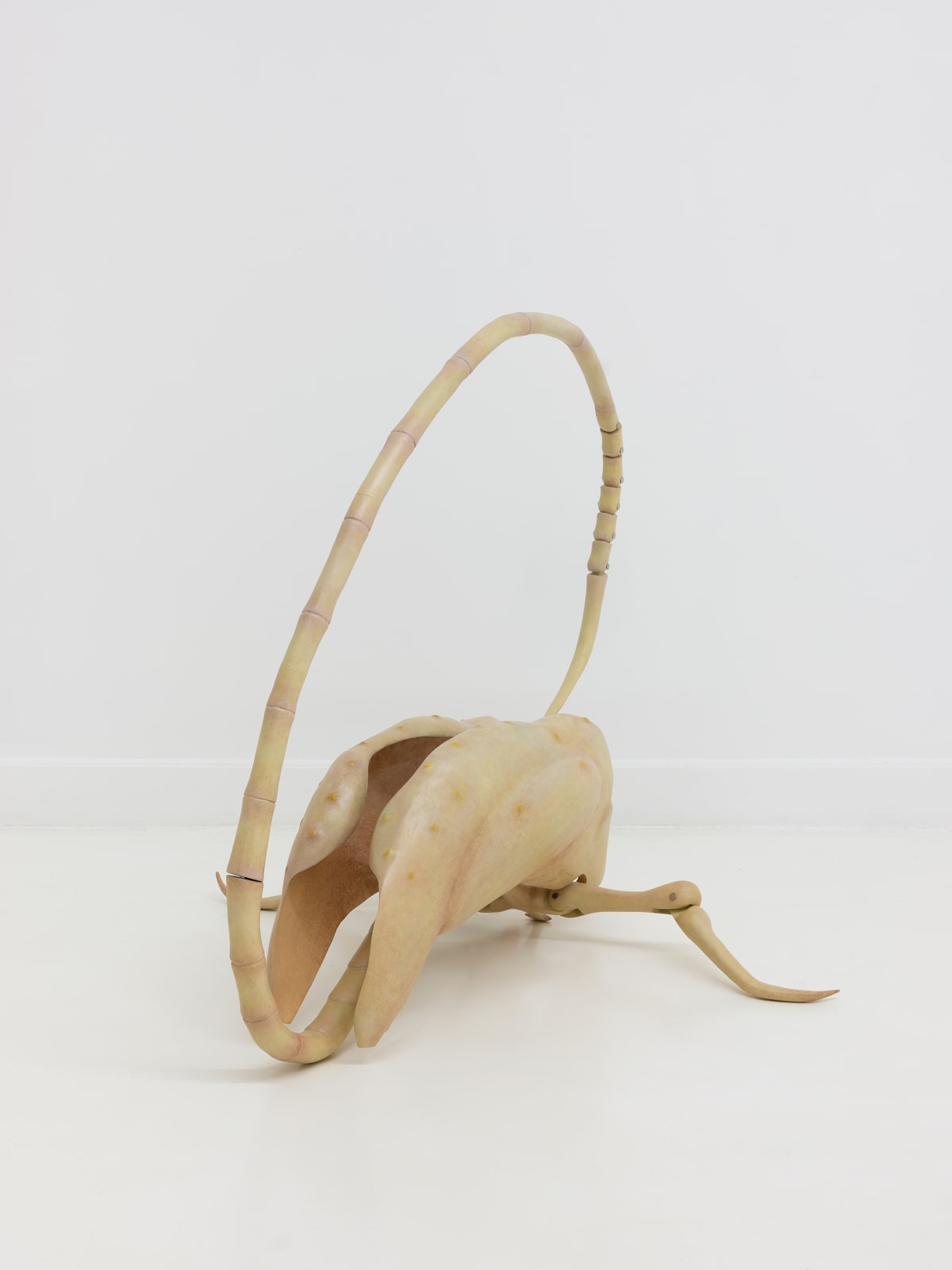Liao Wen 廖雯
Uprise 升, 2021
limewood, silicone, red crystal, pearl 椴木、硅胶、粉水晶、珍珠
90 x 98 x 87 cm
35 1/2 x 38 1/2 x 34 1/2 in
35 1/2 x 38 1/2 x 34 1/2 in
Further images
《升》的灵感来源于古希腊的妇女节。每年秋天,古希腊城邦的妇女们一起去城郊的洞穴里居住三天三夜。仪式第一天的名为“起身”,她们将前一年埋进深坑中的小猪腐肉挖出来;第二天将腐肉、泥土与种子混合在一起,白天她们缄默不语,到日落时分开始吟唱起舞;第三天妇女们各自分得一部分腐肉混合物,并将这个神圣之物埋到自家的农田中。腐肉代表“死亡”的力量,与克制而虔诚的“生”形成强烈对比,我深深地为此着迷。在这场仪式中,女性由身体经验出发,用身体、行动和物的象征转述着她们对自然的感知,用“死亡”去反哺、献祭大地,从而祈求更好的“生”。(廖雯) *Uprise* draws inspiration from the religious festival of Thesmophoria celebrated by women in ancient Greece. Every year, in late autumn, the women of ancient Greek city-states stay together in...
《升》的灵感来源于古希腊的妇女节。每年秋天,古希腊城邦的妇女们一起去城郊的洞穴里居住三天三夜。仪式第一天的名为“起身”,她们将前一年埋进深坑中的小猪腐肉挖出来;第二天将腐肉、泥土与种子混合在一起,白天她们缄默不语,到日落时分开始吟唱起舞;第三天妇女们各自分得一部分腐肉混合物,并将这个神圣之物埋到自家的农田中。腐肉代表“死亡”的力量,与克制而虔诚的“生”形成强烈对比,我深深地为此着迷。在这场仪式中,女性由身体经验出发,用身体、行动和物的象征转述着她们对自然的感知,用“死亡”去反哺、献祭大地,从而祈求更好的“生”。(廖雯)
*Uprise* draws inspiration from the religious festival of Thesmophoria celebrated by women in ancient Greece. Every year, in late autumn, the women of ancient Greek city-states stay together in caves on the outskirts of the city for three days and three nights. On the first day of the festival, which is called anodos, meaning “uprising,” they would dig up the rotten remains of piglets buried in pits the previous year. On the second day, they would mix dirt and seeds together, keep silent during the day, and begin to chant and dance at sunset. On the third day the women each received a portion of the carrion mixture and plant the sacred seeds in their own fields. I was fascinated by the contrast between the power of “death” represented by the rotten flesh and the restraint and reverence assigned to “life.” In this ritual, women use their bodies, actions and symbols of objects to relay their perception of nature from their physical experience, using “death” to feed and sacrifice to the earth, and thus praying for a better “life.” (Liao Wen)
*Uprise* draws inspiration from the religious festival of Thesmophoria celebrated by women in ancient Greece. Every year, in late autumn, the women of ancient Greek city-states stay together in caves on the outskirts of the city for three days and three nights. On the first day of the festival, which is called anodos, meaning “uprising,” they would dig up the rotten remains of piglets buried in pits the previous year. On the second day, they would mix dirt and seeds together, keep silent during the day, and begin to chant and dance at sunset. On the third day the women each received a portion of the carrion mixture and plant the sacred seeds in their own fields. I was fascinated by the contrast between the power of “death” represented by the rotten flesh and the restraint and reverence assigned to “life.” In this ritual, women use their bodies, actions and symbols of objects to relay their perception of nature from their physical experience, using “death” to feed and sacrifice to the earth, and thus praying for a better “life.” (Liao Wen)









